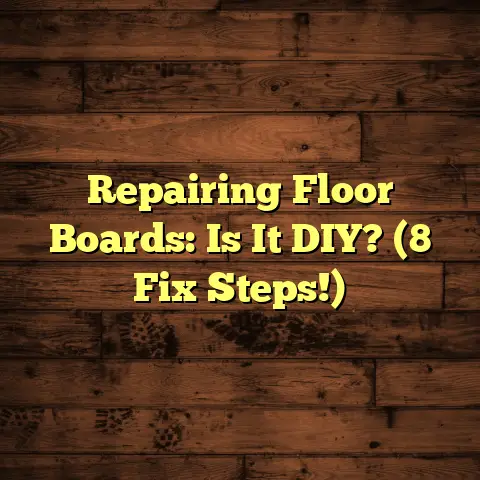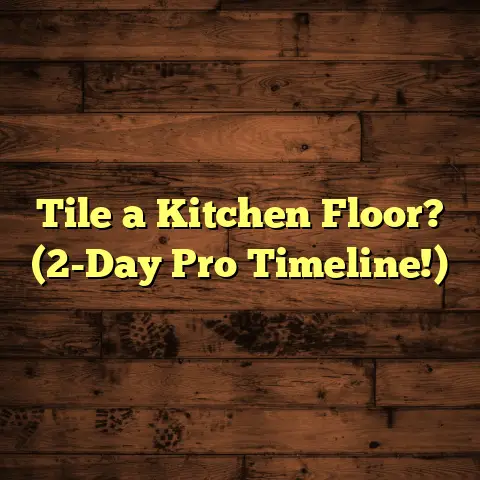Simple Green on Wood? Know This NOW! (2 Risks)
As a flooring contractor with years under my belt, I’ve seen it all – the good, the bad, and the downright ugly when it comes to wood care.
And believe me, protecting your wooden surfaces, especially in those high-moisture zones like kitchens, bathrooms, and even outdoor decks, is absolutely crucial.
Think about it: wood and water? Not exactly BFFs.
That’s where the magic of waterproof options comes in.
We’re talking about those trusty sealants, varnishes, and oil finishes that act like a force field, keeping water damage, stains, and general wear and tear at bay.
But today, I want to talk about something specific: Simple Green.
You know, that popular all-purpose cleaner?
Can you use simple green on wood?
Well, let’s dive in, shall we?
Understanding Simple Green
So, what exactly is Simple Green?
In a nutshell, it’s a cleaning solution designed to tackle a wide range of messes, from greasy grime to everyday dirt.
It’s formulated with biodegradable ingredients, which makes it a hit with folks who are conscious about the environment.
I get it!
We all want to keep our homes clean without harming the planet.
But here’s the thing: Simple Green works by breaking down dirt and grease, and while that’s great for some surfaces, it can be a bit of a wild card when it comes to wood.
Why?
Well, wood is a natural material, and its reaction to cleaning agents can be unpredictable.
Plus, the appeal of using a biodegradable, non-toxic cleaner is undeniable.
I mean, who wouldn’t want a cleaner that’s gentle on the environment and safe for their family?
But before you go spraying Simple Green all over your beautiful hardwood floors, let’s talk about the potential risks.
The Risks of Using Simple Green on Wood
Alright, buckle up, because this is where things get interesting.
Using Simple Green on wood isn’t always a walk in the park.
In fact, it can lead to some serious headaches.
From my experience, there are two major risks you need to be aware of:
Risk 1: Potential Damage to Finish
Wood finishes are like the unsung heroes of your wooden surfaces.
They protect the wood from scratches, stains, and moisture.
But here’s the kicker: Simple Green can mess with those finishes.
I’ve seen it happen time and time again.
The cleaning agents in Simple Green can strip away protective coatings, leaving the wood vulnerable to long-term damage.
Think of it like removing the sunscreen before heading out into the blazing sun – not a good idea, right?
Some finishes are more susceptible than others.
Oil-based varnishes and wax finishes, for example, are particularly vulnerable.
Why?
Because Simple Green can dissolve the oils or waxes, leaving the wood exposed.
And trust me, the visual indicators of finish degradation aren’t pretty.
We’re talking about dullness, cloudiness, and even complete removal of the finish in some areas.
When that happens, you’re looking at refinishing or even restoration – a costly and time-consuming process.
Risk 2: Absorption and Swelling
Wood is a porous material, meaning it has tiny little holes that can absorb moisture.
Now, a little moisture is usually no big deal.
But when you’re using a cleaner like Simple Green, you’re essentially drenching the wood with water, which can lead to excessive absorption.
And what happens when wood absorbs too much water?
It swells.
I’m talking about warping, cracking, and even the growth of mold or mildew in severe cases.
I remember one case where a homeowner used Simple Green to clean their wood floors every week.
Within a few months, the floors started to buckle and warp.
The culprit?
Excessive moisture absorption from the Simple Green.
It was a costly mistake that could have been avoided with a little knowledge and the right cleaning products.
Alternative Cleaning Solutions for Wood
Okay, so Simple Green might not be the best choice for wood.
But don’t worry, there are plenty of safer alternatives out there!
When it comes to cleaning wood, I always recommend using products specifically designed for wood surfaces.
These cleaners are formulated to clean effectively without posing risks to the wood finish or structure.
Look for pH-neutral cleaners, as these are less likely to damage the finish.
You can also whip up some natural cleaning solutions right at home.
A mixture of vinegar and olive oil can work wonders on wood, as can a simple soap and water solution.
Just be sure to use a mild soap and avoid over-wetting the wood.
And remember, a gentle approach is key when cleaning wood.
Use a soft cloth and avoid abrasive methods that can scratch or damage the finish.
Conclusion
So, there you have it – the lowdown on Simple Green and wood.
While Simple Green is a great all-purpose cleaner, it’s not always the best choice for your wooden surfaces.
The risks of damaging the finish and causing excessive moisture absorption are simply too high.
I’ve seen the damage firsthand, and trust me, it’s not pretty.
The key takeaway here is to understand how cleaning products interact with wooden surfaces.
Not all cleaners are created equal, and what works for one surface might not work for another.
When it comes to maintaining your wooden items, it’s all about making informed decisions.
You want to strike a balance between cleanliness and preservation, ensuring that your wood stays beautiful and lasts for years to come.
And remember, using the right products for the right materials is always a smart move.
It’s an investment in the longevity and beauty of your wooden surfaces.
So, the next time you’re reaching for that bottle of Simple Green, take a moment to consider the potential risks.
Your wood will thank you for it!





